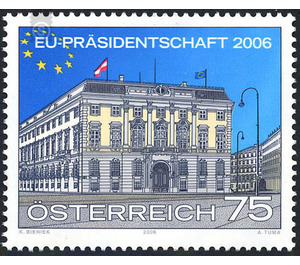EU Presidency - Austria / II. Republic of Austria 2006 - 75 Euro Cent
Theme: History & Politics
| Country | Austria / II. Republic of Austria |
| Issue Date | 2006 |
| Face Value | 75.00 |
| Edition Issued | 800,000 |
| Printing Type | combination printing |
| Stamp Type | Commemorative |
| Item Type | Stamp |
| Chronological Issue Number | 1908 |
| Chronological Chapter | OOS-OE2 |
| SID | 447824 |
| In 54 Wishlists | |
Under the statutes of the institution of the European Union and other institutions, the Presidency of the Council of the European Union, the EU's main decision-making body, changes every six months. This means that all EU countries are alternately responsible for the Council's agenda for six months each and chairing all meetings, advancing legislative and political decisions and making compromises among member states. Austria will take over the EU Presidency from England on 1 January 2006, lead it until 30 June 2006 and hand over the chairmanship to Finland for the second half of the year. The EU Council represents the member states and at its meetings a minister from the national governments of the EU states takes part. All Ministers represented in the Council have the power to bind their governments, and their signatures sign the entire government's signature. There are a total of nine different compositions of the Council. Nevertheless, the Council remains only one organ. The central tasks of the Council, such as the adoption of European legislation together with the European Parliament, the coordination of the Broad Economic Policy Guidelines, the conclusion of international agreements and the approval of the budget, are the responsibility of the European Parliament. In addition there is the regulation of intergovernmental cooperation in the area of common foreign and security policy as well as in the area of police and justice. Since February 2002, the "Convention on the Future of Europe" has drafted a Treaty establishing a Constitution for Europe. In October 2004, the Constitutional Treaty was solemnly signed by the Heads of State and Government in Rome. It must be ratified by the individual Member States in the following months. The Constitution will only enter into force once it has been ratified by all EU states. Ratification took place in Austria, as in other states, through the vote in Parliament. In some countries, approval depends on a referendum. This brought in France and in the Netherlands a negative result. Since then, the project of an EU constitution has been stopped for the time being. The Treaty of Nice is valid for the EU. They currently regulate the activities of EU political bodies. The new common constitution would have clearly enshrined fundamental rights such as freedom of expression, equality between men and women or the prohibition of the death penalty in European law. It would have redefined the voice of EU citizens, strengthened local and regional self-government, and explicitly recognized the equal rights of all Member States. The new constitution would also include organizational changes. In the future, there would be a President of the European Council who will be elected for two and a half years - instead of the previous change of Chairmanship every six months, and there would also be a separate EU Foreign Minister. Austria's EU Presidency in the first half of 2006 will be a difficult period for European politics: the negotiations on the 2007-2012 EU financial plan are pending. The stalled ratification process over the EU Constitution, accession negotiations with Turkey and Croatia, the situation in the Balkans will demand a lot of skill from Austria's responsible politicians.


